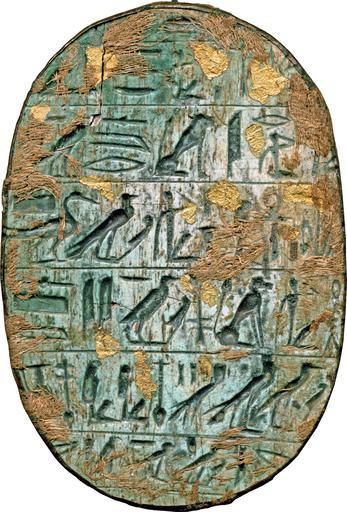MAKE A MEME
View Large Image

| View Original: | Egyptian_-_Scarab_with_Pseudo-text_-_Walters_421_-_Bottom.jpg (1221x1801) | |||
| Download: | Original | Medium | Small | Thumb |
| Courtesy of: | commons.wikimedia.org | More Like This | ||
| Keywords: Egyptian - Scarab with Pseudo-text - Walters 421 - Bottom.jpg The ancient Egyptians believed that the dung beetle the Scarabaeus sacer was one of the manifestations of the sun god Representations of these beetles were used as amulets and for ritual or administrative purposes The back of this large scarab has its highest point at the elytron wing cases Partition and division lines of pronotum dorsal plate of the prothorax and elytron are covered with a setting of golden bands The rectangular head is flanked by semi-ovoid eyes; the side plates are trapezoidal with curved outer edges and the clypeus front plate is five times serrated The raised slender extremities have natural form and the background between the legs is hollowed out The shape of the low base is symmetrically long-oval The inscription on the bottom has seven lines of a left reading text and seven horizontal text dividers; the inscription is framed by an oval line The bottom inscription is executed in sunk relief or linearly incised; the hieroglyphs are slim and elongated some have inner structures and some are slightly disproportional; the layout has several irregularities such as lopsided signs or hoe-like pseudo-hieroglyphs which collide with the outer border The execution of back and bottom differs the back and sides are carefully formed but the bottom inscription is very rough The gold leaf and linen fragments are randomly attached The scarab is pierced lengthwise what normally refers to an additional mount or support but is unusual for a Heart scarab of this large size The scarab shows several discrepancies which lead to the conclusion that it was produced in modern times Most probably it imitates a Heart scarab which was made to be placed on the chest of a mummy To give it a more ancient look linen fragments were attached and to make it more precious small pieces of gold foil added The following discrepancies have to be mentioned - The text on the back is not a direct copy of an original Heart scarab and was created without adequate knowledge of ancient Egyptian language and script; - the script style has no ancient Egyptian parallel; - the name of an owner is missing and there is also not enough empty space to add a name as in unused prefabricated Heart scarabs; - the gold bands on the back seem to be copied from settings of hard stone scarabs but without understanding of the function of the bands as a setting; - a longitudinal drill would be unusual for a scarab of this size; - traces of the mummy wrappings would normally not adhere to the body of a glazed scarab and may have been adapted from wooden pieces late 19th-early 20th century light brown steatite with blue-green glaze gold leaf and linen cm 3 3 5 9 8 7 accession number 42 1 38790 Henry Walters city Baltimore Walters Art Museum Henry Walters Acquired by Henry Walters 1924 Inscription The inscription provides no clear context; the producer just copied words and signs Some signs have no real comparison in Egyptian script such as the baboon-headed animal with the tail of the god Seth or the short how-signs at the right and left edge of the lowest line and others are reversed or upside down There are also no obvious parallels to enigmatic texts or cryptographic writings place of origin Egypt Walters Art Museum license Ancient Egyptian scarabs in the Walters Art Museum Media contributed by the Walters Art Museum needs category review | ||||